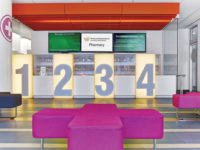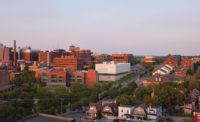The Hotel Grinnell in Iowa makes no pretenses about being housed in the town’s former junior high. Perkins+Will designed the 65,000-square-foot hotel to embrace the 1921 building’s history and strengthen its ties to the local community by highlighting and repurposing original details in the new-concept hotel. “It’s a true boutique hotel, the way they used to be,” says Jacqueline McGee, a Perkins+Will design principal, explaining the hotel has the typical limited number of guestrooms, an urban location, and a strong concept. The owner, a former executive of the local chamber of commerce and visitors bureau, had a vision for something that could host visitors to Grinnell College and celebrate broader reinvestment in the town.
To start, building products were sourced with an emphasis on social purpose. For example, rooms contain paintings by local artists; an Iowa-based manufacturer fabricated the iron beds, armoires, vanities, and table bases; and a woman-owned company produced the OEKO-TEX-certified bedding and bath linens.
“This hotel has become a labor of love for the whole community,” says McGee. For that reason, the hotel needed to be inviting to locals as well as out-of-towners. Therefore, it houses a lounge, an outdoor dining space, a ballroom, and a 450-seat auditorium in addition to its 43 guestrooms and suites. Architects formed these areas in spaces previously occupied by classrooms on three levels. Historic preservation concerns precluded removing existing terrazzo floors or narrowing eight-foot-wide corridors to expand guestrooms. As a result, rooms vary in size from 250 to 300 square feet and range from 12 feet to 15 feet wide, to make use of narrow footprints left by the classrooms. In some cases, sinks had to be located outside the ensuite bathrooms. Oversize windows and 15-foot-tall vaulted ceilings, original to the building, were also restored to save the building’s original details and let in additional daylight.
In the tradition of community-driven youth hostels, architects designed two bunkrooms in a space that was formerly a corridor behind the school cafeteria. Each has 10 bunkbeds, a bathroom with two vanities, a shower, and toilets—ideal for sports teams competing against the local college.
In the Periodic Bar and a coffee lounge, which replace the old locker room, vintage-style checkerboard flooring enlivens gray-painted walls, and a motley array of chair seating styles in metal, wood, leather, and fabric create a casual atmosphere. The bar includes a gaming area, complete with an oversized Scrabble board. This space connects to an outdoor patio where guests can sit and relax around a fire pit.
The ballroom accommodates up to 350 people in what was once the school gymnasium. Basketball court lines were repainted on the original refinished wood floor to impart a sense of nostalgic fun, and small-aperture LED downlights stud a black-painted ceiling for a starry “prom night” effect.
Myriad similar design references to the building’s past influence its new identity, including a chalkboard in every guestroom, benches in guestrooms built from old lockers, and a scoreboard in the hotel bar. McGee credits the client’s entrepreneurial spirit for the successful design scheme. Feels like school spirit to us.







Post a comment to this article
Report Abusive Comment